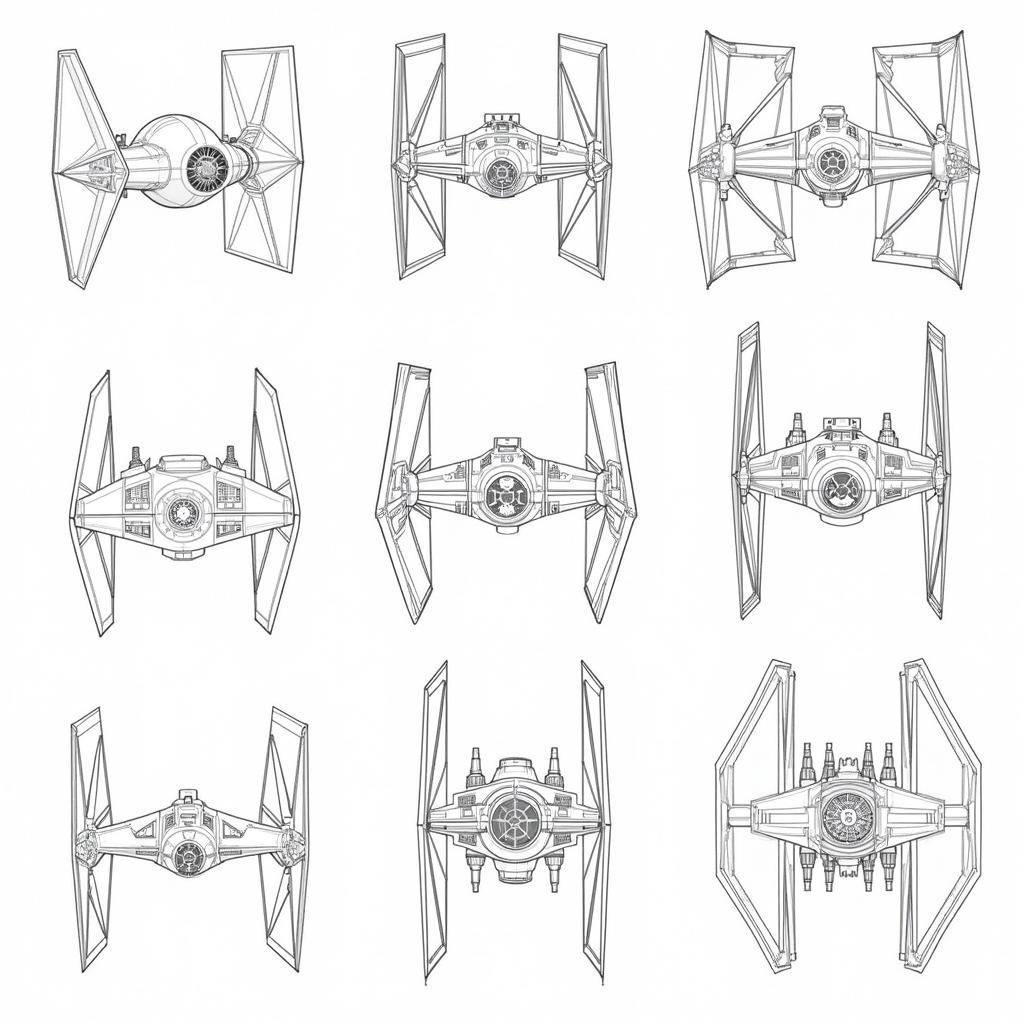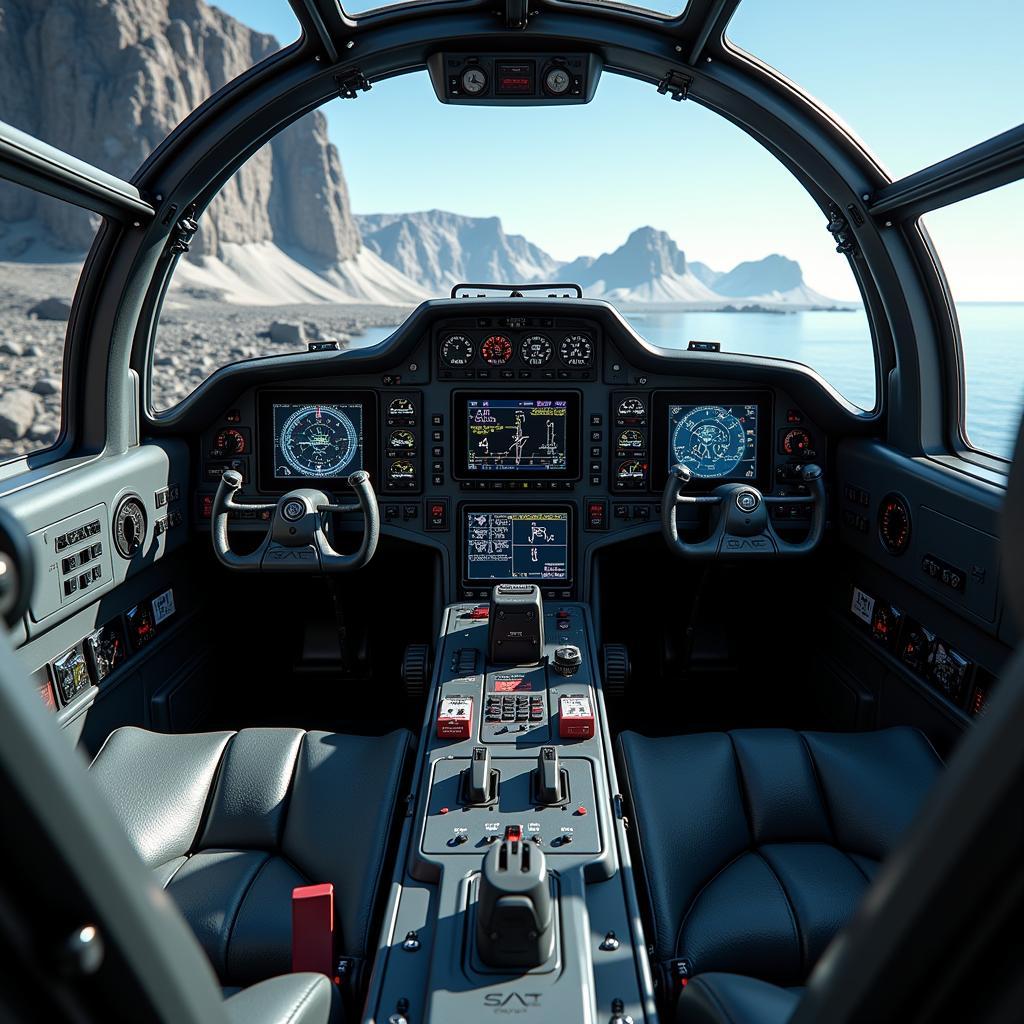The TIE interceptor, a sleek and deadly symbol of Imperial might, needs no introduction to Star Wars fans. This advanced starfighter, easily recognized by its dagger-shaped solar panels, was a common sight in the final years of the Galactic Civil War. But what made the TIE interceptor such a formidable weapon in the Empire’s arsenal? Let’s delve into the history, design, and capabilities of this iconic starfighter.
Origins and Development of the TIE Interceptor
 TIE Interceptor Design Evolution
TIE Interceptor Design Evolution
The TIE interceptor was born from the Empire’s need for a faster and more agile starfighter to counter the Rebel Alliance’s growing fleet. The standard TIE fighter, while effective in swarms, lacked the speed and maneuverability to match Rebel fighters like the X-wing and A-wing. Recognizing this weakness, the Empire tasked Sienar Fleet Systems, the creators of the original TIE fighter, with developing a superior alternative.
The result was the TIE interceptor, a starfighter that combined the firepower of the TIE fighter with enhanced speed and agility. Introduced late into the Galactic Civil War, the TIE interceptor quickly proved its worth, becoming a favorite among elite Imperial pilots tasked with engaging the Rebellion’s best starfighters in dogfights.
Design and Capabilities: A Closer Look
 TIE Interceptor Cockpit
TIE Interceptor Cockpit
The TIE interceptor’s design is a testament to the Empire’s focus on functionality over form. Its most striking feature is its dagger-shaped solar array wings, a departure from the hexagonal panels of its predecessor. This design, combined with a more powerful engine system, granted the TIE interceptor significantly increased speed and maneuverability.
While sacrificing some armor for speed, the TIE interceptor boasted a formidable arsenal. It came equipped with four laser cannons mounted on its wingtips, offering concentrated firepower capable of tearing through enemy shields and hulls.
Key Features of the TIE Interceptor:
- Superior Speed and Maneuverability: Outpacing even the agile A-wing in short bursts, the TIE interceptor dominated close-range engagements.
- Enhanced Firepower: Four laser cannons provided concentrated firepower, allowing pilots to quickly eliminate enemy targets.
- Advanced Targeting Computer: Like its TIE fighter predecessor, the interceptor possessed an advanced targeting computer, increasing its accuracy in combat.
- Limited Shielding: While lacking the deflector shields of Rebel fighters, the TIE interceptor’s speed and maneuverability often compensated for this vulnerability.
Notable Pilots and Engagements
The TIE interceptor was often entrusted to the most skilled pilots within the Imperial Navy. These elite pilots, handpicked from the ranks of the Imperial Starfighter Corps, underwent rigorous training to master the interceptor’s unique capabilities.
One notable pilot was Soontir Fel, an ace pilot known for his exceptional skill and unwavering loyalty to the Empire. Fel’s mastery of the TIE interceptor made him a formidable opponent, earning him a fearsome reputation among Rebel pilots. He flew his heavily modified TIE interceptor, the 181st, to victory in numerous engagements.
The TIE interceptor saw significant action in key battles of the Galactic Civil War, including the Battle of Endor. During this pivotal battle, TIE interceptors clashed with Rebel fighters amidst the debris field of the second Death Star, their speed and agility proving critical in the chaotic space battle.
The TIE Interceptor: A Lasting Legacy
Despite the eventual defeat of the Galactic Empire, the TIE interceptor secured its place as one of the most recognizable and feared starfighters in the galaxy. Its iconic design, impressive speed, and deadly firepower have cemented its status as a fan favorite and a symbol of Imperial might. The TIE interceptor serves as a reminder of the technological prowess of the Galactic Empire, even in the face of defeat.
Frequently Asked Questions about the TIE Interceptor
1. How fast was the TIE interceptor compared to other starfighters?
The TIE interceptor was renowned for its speed, surpassing even the A-wing in short bursts. While exact figures are debated among fans, its superior speed was undeniable.
2. Did the TIE interceptor have any weaknesses?
Its primary weakness was the lack of deflector shields, a standard feature on Rebel starfighters. However, this was often offset by its exceptional speed and maneuverability, allowing skilled pilots to evade enemy fire.
3. Were there different variants of the TIE interceptor?
Yes, while the standard TIE interceptor was the most common, several specialized variants were developed, including the TIE/D Defender, which boasted enhanced weaponry and deflector shields.
4. Could the TIE interceptor make the jump to hyperspace?
No, like most TIE series starfighters, the TIE interceptor lacked a hyperdrive and relied on support ships for long-range travel.
5. Are there any known surviving TIE interceptors after the Battle of Endor?
The fate of the TIE interceptor after the fall of the Empire is largely unknown. Some speculate that surviving units may have fallen into the hands of various factions or collectors throughout the galaxy.
For any assistance, please contact us at Phone Number: 0902476650, Email: [email protected] or visit our address: 139 Đ. Võ Văn Kiệt, Hoà Long, Bà Rịa, Bà Rịa – Vũng Tàu, Việt Nam. We have a 24/7 customer support team available.





